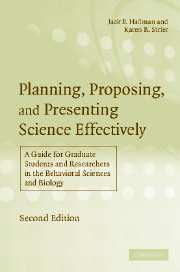 Planning, Proposing, and Presenting Science Effectively
Planning, Proposing, and Presenting Science Effectively 4 - How to present research
Published online by Cambridge University Press: 01 September 2010
Summary
The speaking in perpetual hyperbole is comely in nothing but love.
Francis Bacon (1561–1626)The science that is discussed in a scientific presentation, like the science described in written proposals and reports, can fail to make an impression if the presentation is lacking in clarity, organization, and interest value. Therefore, learning how to give effective scientific presentations is as important in communicating your research findings as any written product.
The three main types of scientific presentation are seminars or colloquia, oral papers at professional meetings, and posters. Seminars and meeting papers are spoken presentations that differ primarily in length and, consequently, content; poster presentations are mounted on a panel and read by passersby. In this chapter, we provide suggestions for how to prepare and present scientific seminars and both oral and poster papers. Most of our advice is derived from our own experiences as speakers, members of audiences, and session or seminar organizers. In addition, Appendix A provides tips on how to write clearly, many of which apply to construction of slides for oral presentations and creation of poster papers.
Seminars are usually allotted an hour or so, with the expectation that the speaker will talk for about 45 minutes and will answer audience questions during the remainder of the time. Meeting presentations are usually limited to 15 or 20 minutes each, with the expectation that the speaker will talk for about 12 or 17 minutes, respectively, and respond to questions during the remaining minutes.
- Type
- Chapter
- Information
- Planning, Proposing, and Presenting Science EffectivelyA Guide for Graduate Students and Researchers in the Behavioral Sciences and Biology, pp. 108 - 148Publisher: Cambridge University PressPrint publication year: 2006


